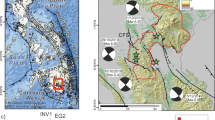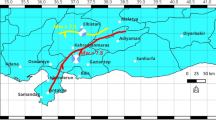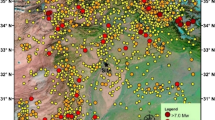Abstract
Recurrent groundwater radon anomalous declines were observed from well measurements in the Antung hot spring area (eastern Taiwan) prior to five of six earthquakes that occurred between 2003 and 2011 (M w range 5.0–6.8). The relationship between the detectability of radon anomalies and the first motions of P-waves was investigated. Based on the first motions of P-waves recorded near the investigated well, a precursory decrease in groundwater radon can be detected only when the first motion is compression. No precursory change in groundwater radon concentration was observed for the downward first motion of P-waves.
Similar content being viewed by others
References
Attanasio, A., & Maravalle, M. (2016). Some considerations between radon and earthquakes in the crater of L’Aquila. Natural Hazards, 81, 1971–1979. doi:10.1007/s11069-016-2169-4.
Brace, W. F., Paulding, B. W., Jr., & Scholz, C. H. (1966). Dilatancy in the fracture of crystalline rocks. Journal Geophysical Research, 71, 3939–3953. doi:10.1029/JZ071i016p03939.
Carminati, E., Doglioni, C., & Barbab, S. (2004). Reverse migration of seismicity on thrusts and normal faults. Earth Science Reviews, 65, 195–222. doi:10.1016/S0012-8252(03)00083-7.
Chen, W. S., & Wang, Y. (1996). Geology of the Coastal Range, eastern Taiwan. Geology of Taiwan 7. Central Geological Survey, Taiwan.
Doglionia, C., Barbab, S., Carminatia, E., & Riguzzib, F. (2011). Role of the brittle–ductile transition on fault activation. Physics of the Earth and Planetary Interiors, 184, 160–171. doi:10.1016/j.pepi.2010.11.005.
Doglionia, C., Barbab, S., Carminatia, E., & Riguzzib, F. (2013). Fault on–off versus coseismic fluids reaction. GSF, 5, 767–780. doi:10.1016/j.gsf.2013.08.004.
Erees, F. S., Aytas, S., Sac, M. M., Yener, G., & Salk, M. (2007). Radon concentrations in thermal waters related to seismic events along faults in the Denizli Basin, Western Turkey. Radiation Measurements, 42, 80–86. doi:10.1016/j.radmeas.2006.06.003.
Hashemi, S. M., Negarestani, A., Namvaran, M., & Musavi Nasab, S. M. (2013). An analytical algorithm for designing radon monitoring network to predict the location and magnitude of earthquakes. Journal of Radioanalytical and Nuclear Chemistry, 295, 2249–2262. doi:10.1007/s10967-012-2310-0.
Hauksson, E. (1981). Radon content of groundwater as an earthquake precursor: evaluation of worldwide data and physical basis. Journal Geophysical Research, 86, 9397–9410. doi:10.1029/JB086iB10p09397.
Hsu, T. L. (1962). Recent faulting in the Longitudinal Valley of eastern Taiwan. Geological Society of China, 1, 95–102.
Igarashi, G., Saeki, S., Takahata, N., Sumikawa, K., Tasaka, S., Sasaki, Y., et al. (1995). Ground-water radon anomaly before the Kobe earthquake in Japan. Science, 269, 60–61. doi:10.1126/science.269.5220.60.
Kuo, T. (2014). Correlating precursory declines in groundwater radon with earthquake magnitude. Ground Water, 52, 217–224. doi:10.1111/gwat.12049.
Kuo, T., Fan, K., Kuochen, H., & Chen, W. (2006a). A mechanism for anomalous decline in radon precursory to an earthquake. Ground Water, 44, 642–647. doi:10.1111/j.1745-6584.2006.00219.x.
Kuo, T., Fan, K., Kuochen, H., Han, Y., Chu, H., & Lee, Y. (2006b). Anomalous decrease in groundwater radon before the Taiwan M6.8 Chengkung earthquake. Journal of Environmental Radioactivity, 88, 101–106. doi:10.1016/j.jenvrad.2006.01.005.
Namvaran, M., & Negarestani, A. (2013). Measuring the radon concentration and investigating the mechanism of decline prior an earthquake (Jooshan, SE of Iran). Journal of Radioanalytical and Nuclear Chemistry, 298, 1–8. doi:10.1007/s10967-013-2162-7.
Noguchi, M. (1964). New method of radon activity measurement with liquid scintillator. Radioisotopes, 13, 362–367. doi:10.3769/radioisotopes.13.5_362.
Noguchi, M., & Wakita, H. (1977). A method for continuous measurement of radon in groundwater for earthquake prediction. Journal Geophysical Research, 82, 1353–1357. doi:10.1029/JB082i008p01353.
Nur, A. (1972). Dilatancy, pore fluids, and premonitory variations of ts/tp travel times. Bulletin of the Seismological Society of America, 62, 1217–1222.
Papastefanou, C. (2002). An overview of instrumentantion for measuring radon in soil gas and groundwaters. Journal of Environmental Radioactivity, 63, 271–283. doi:10.1016/S0265-931X(02)00034-6.
Scholz, C. H., Sykes, L. R., & Aggarwal, Y. P. (1973). Earthquake prediction: a physical basis. Science, 181, 803–810. doi:10.1126/science.181.4102.803.
Shapiro, M. H., Melvin, J. D., & Tombrello, T. A. (1980). Automated radon monitoring at a hard-rock site in the southern California transverse ranges. Journal Geophysical Research, 85, 3058–3064. doi:10.1029/JB085iB06p03058.
Shearer, P. M. (2009). Introduction to seismology. Cambridge, UK: Cambridge University Press.
Tarakçı, M., Harmanşah, C., Saç, M. M., & İçhedef, M. (2014). Investigation of the relationships between seismic activities and radon level in western Turkey. Applied Radiation and Isotopes, 83, 12–17. doi:10.1016/j.apradiso.2013.10.008.
Torgersen, T., Benoit, J., & Mackie, D. (1990). Controls on groundwater Rn-222 concentrations in fractured rock. Geophys. Res. Lett., 17, 845–848. doi:10.1029/GL017i006p00845.
Tuccimei, P., Mollo, S., Soligo, M., Scarlato, P., & Castelluccio, M. (2015). Real-time setup to measure radon emission during rock deformation: implications for geochemical surveillance. Geoscientific Instrumentation, Methods and Data Systems, 4, 111–119. doi:10.5194/gi-4-111-2015.
Wakita, H., Nakamura, Y., Notsu, K., Noguchi, M., & Asada, T. (1980). Radon anomaly: a possible precursor of the 1978 Izu-Oshima-kinkai earthquake. Science, 207, 882–883. doi:10.1126/science.207.4433.882.
Yalim, H. A., Sandıkcıoğlua, A., Ünala, R., & Orhunb, Ö. (2007). Measurements of radon concentrations in well waters near the Akşehir fault zone in Afyonkarahisar, Turkey. Radiation Measurements, 42, 505–508. doi:10.1016/j.radmeas.2006.12.013.
Zmazek, B., Todorovski, L., Živčić, M., Džeroski, S., Vaupotiča, J., & Kobala, I. (2006). Radon in a thermal spring: identification of anomalies related to seismic activity. Applied Radiation and Isotopes, 64, 725–734. doi:10.1016/j.apradiso.2005.12.016.
Acknowledgements
Supports by the Ministry of Science and Technology Taiwan (NSC, MOST), Central Geological Surveys, Industrial Technology Research Institute (L550001060, N550003318), Radiation Monitoring Center, and Institute Earth Sciences of Academia Sinica of Taiwan are appreciated. The authors are grateful to Mr. C. Lin of the Antung hot spring for his kind field assistance.
Author information
Authors and Affiliations
Corresponding author
Rights and permissions
About this article
Cite this article
Kuo, T., Kuochen, H., Ho, C. et al. A Stress Condition in Aquifer Rock for Detecting Anomalous Radon Decline Precursory to an Earthquake. Pure Appl. Geophys. 174, 1291–1301 (2017). https://doi.org/10.1007/s00024-016-1461-2
Received:
Revised:
Accepted:
Published:
Issue Date:
DOI: https://doi.org/10.1007/s00024-016-1461-2










